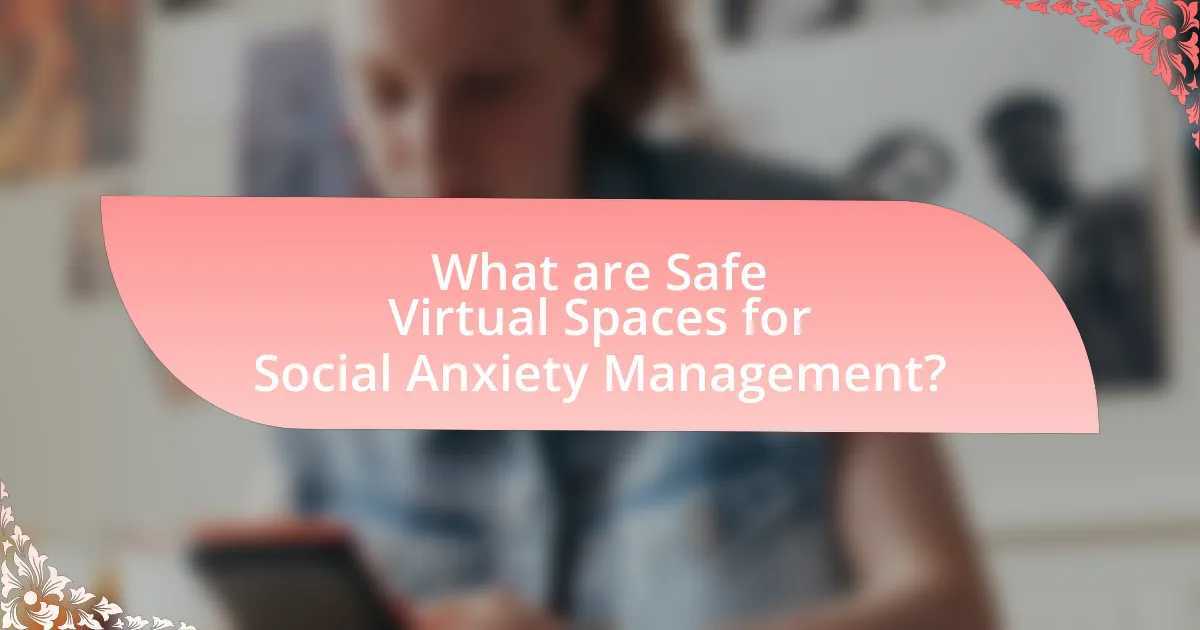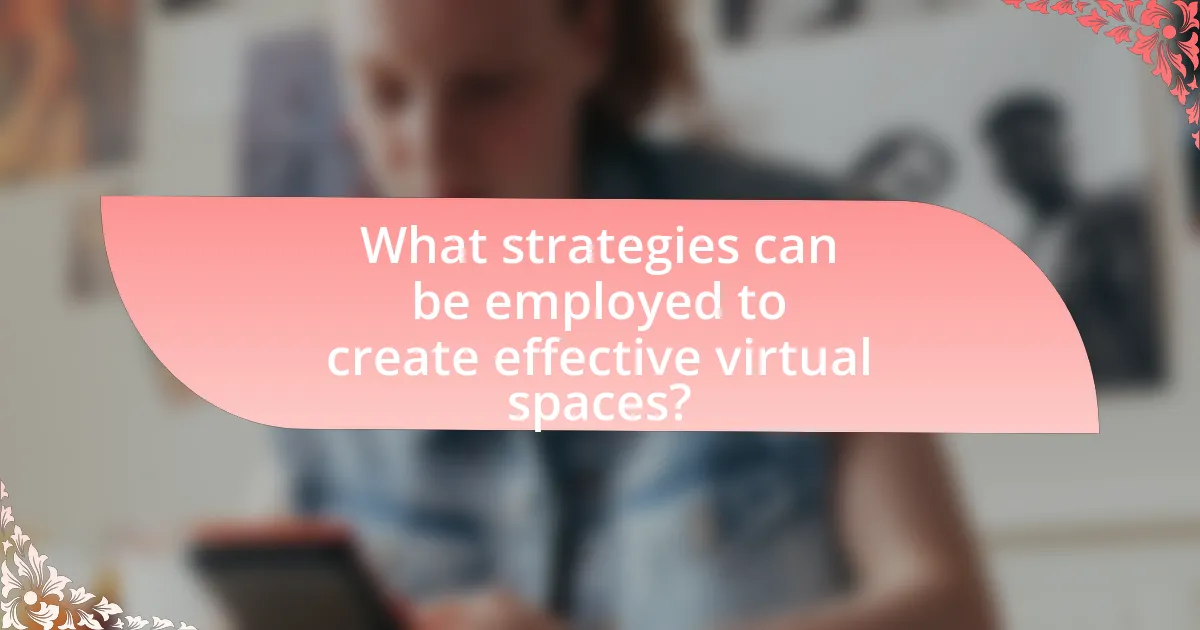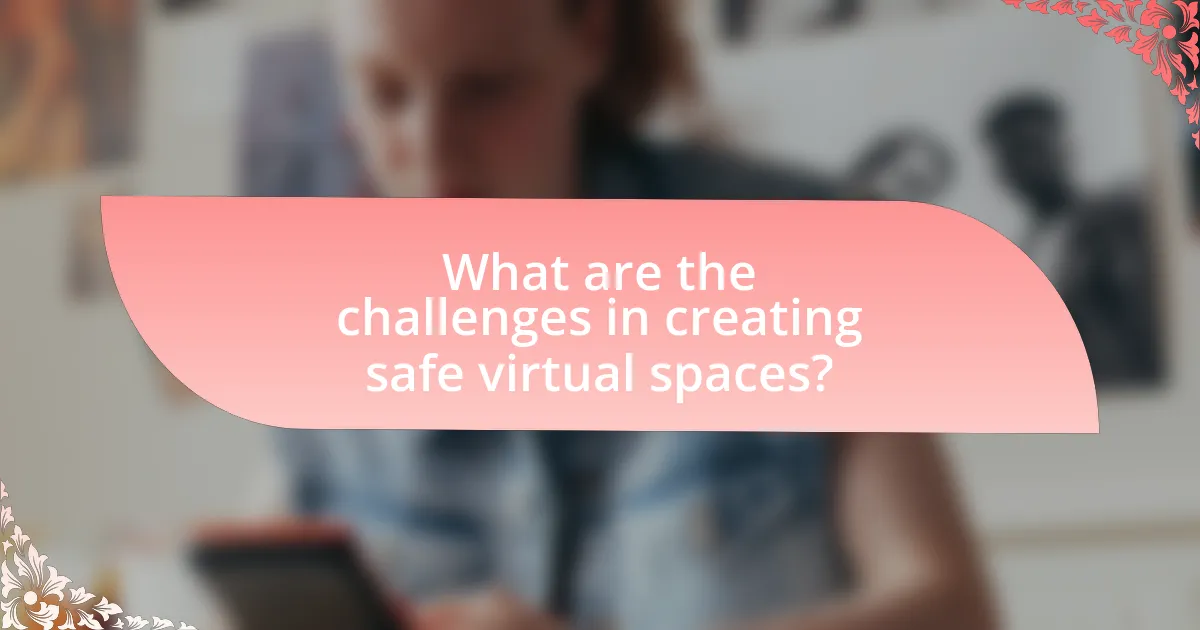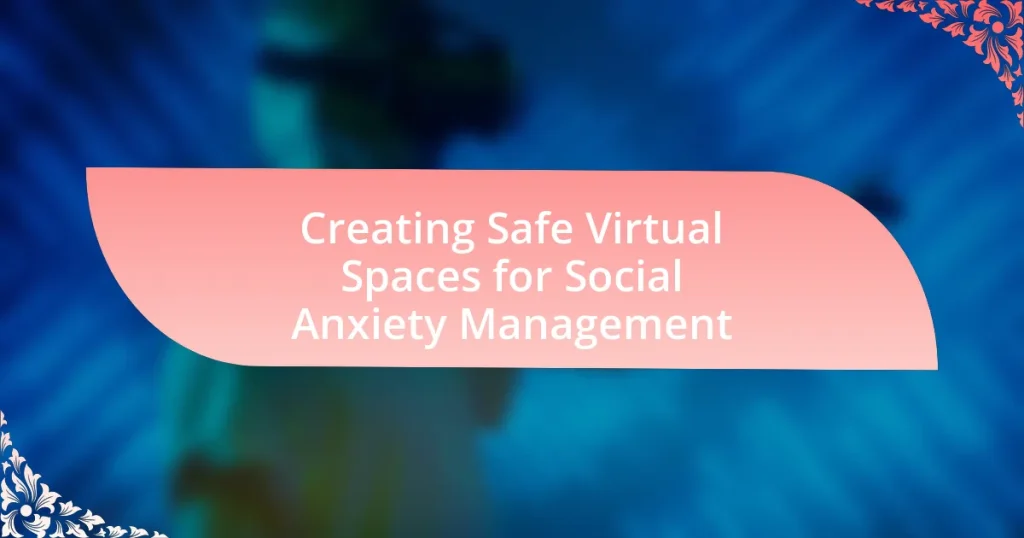The article focuses on creating safe virtual spaces for managing social anxiety, highlighting the importance of online support groups, therapy platforms, and social skills training websites. It discusses how these environments differ from traditional support settings by offering accessibility, anonymity, and controlled interactions, which can significantly reduce feelings of isolation and anxiety. Key features that contribute to the safety of these virtual spaces include anonymity, supportive community guidelines, and controlled interactions. The article also examines the role of community, peer support, and effective moderation in fostering a positive atmosphere, while addressing challenges such as privacy concerns and managing negative behaviors. Additionally, it outlines best practices for users to maximize their experience and provides resources for connecting with mental health professionals online.

What are Safe Virtual Spaces for Social Anxiety Management?
Safe virtual spaces for social anxiety management include online support groups, therapy platforms, and social skills training websites. These environments provide individuals with social anxiety a controlled setting to interact with others, share experiences, and receive support without the pressure of face-to-face interactions. Research indicates that online support groups can significantly reduce feelings of isolation and anxiety, as evidenced by a study published in the Journal of Anxiety Disorders, which found that participants reported lower anxiety levels after engaging in virtual support communities. Additionally, platforms like BetterHelp and Talkspace offer professional therapy services that cater specifically to individuals with social anxiety, allowing for personalized coping strategies and therapeutic interventions.
How do these spaces differ from traditional support environments?
Safe virtual spaces for social anxiety management differ from traditional support environments primarily in their accessibility and anonymity. Unlike traditional support environments, which often require physical presence and can induce anxiety due to face-to-face interactions, virtual spaces allow individuals to engage from the comfort of their own homes, reducing the pressure associated with in-person meetings. Research indicates that online support groups can lead to increased participation and comfort for individuals with social anxiety, as they can communicate through text or video without the immediate stress of physical presence. This format also enables a broader reach, allowing individuals from diverse geographical locations to connect, which is often not possible in traditional settings.
What features make a virtual space safe for individuals with social anxiety?
A virtual space is safe for individuals with social anxiety when it incorporates features such as anonymity, controlled interactions, and supportive community guidelines. Anonymity allows users to engage without the pressure of revealing their identity, which can significantly reduce anxiety levels. Controlled interactions, such as options to mute or block others, empower users to manage their engagement and avoid overwhelming situations. Supportive community guidelines foster a positive environment by discouraging negative behaviors and promoting inclusivity, which has been shown to enhance user comfort and participation. These features collectively create a supportive atmosphere that can help individuals with social anxiety feel more secure and willing to engage.
How do anonymity and privacy contribute to safety in virtual spaces?
Anonymity and privacy enhance safety in virtual spaces by allowing individuals to engage without fear of judgment or repercussions. This protective layer encourages open communication, particularly for those with social anxiety, as it reduces the pressure of social evaluation. Research indicates that environments prioritizing anonymity can lead to increased participation and sharing of personal experiences, which is crucial for support and connection. For instance, a study published in the Journal of Computer-Mediated Communication found that anonymity significantly increases self-disclosure, fostering a sense of safety among users. Thus, anonymity and privacy are essential for creating supportive virtual environments that facilitate social interaction and mental health management.
Why is creating these spaces important for social anxiety management?
Creating safe virtual spaces is crucial for social anxiety management because they provide individuals with a controlled environment to practice social interactions without the overwhelming pressure of face-to-face encounters. These spaces allow users to engage at their own pace, reducing feelings of anxiety and fostering a sense of community. Research indicates that online support groups can significantly decrease anxiety levels, as participants report feeling more comfortable expressing themselves in a virtual setting compared to traditional in-person meetings. This comfort can lead to improved social skills and increased confidence over time, making virtual spaces an effective tool in managing social anxiety.
What impact does social anxiety have on individuals’ daily lives?
Social anxiety significantly impacts individuals’ daily lives by causing distress in social situations, leading to avoidance behaviors and impaired functioning. Individuals with social anxiety often experience intense fear of judgment or embarrassment, which can hinder their ability to engage in everyday activities such as attending work, participating in social gatherings, or even making phone calls. Research indicates that approximately 12.1% of the U.S. population experiences social anxiety disorder at some point in their lives, which can result in decreased quality of life and increased risk of comorbid conditions like depression. This pervasive fear can lead to isolation, reduced social support, and difficulties in forming relationships, ultimately affecting overall well-being and mental health.
How can virtual spaces provide support that traditional methods may lack?
Virtual spaces can provide support that traditional methods may lack by offering a safe and controlled environment for individuals to engage socially without the immediate pressures of face-to-face interactions. This setting allows users to gradually build confidence and practice social skills at their own pace, which is particularly beneficial for those with social anxiety. Research indicates that online platforms can reduce feelings of isolation and provide access to a broader support network, as individuals can connect with others who share similar experiences regardless of geographical limitations. For instance, a study published in the Journal of Anxiety Disorders found that participants who engaged in online support groups reported significant reductions in anxiety symptoms compared to those who relied solely on traditional in-person therapy.

What strategies can be employed to create effective virtual spaces?
To create effective virtual spaces, it is essential to implement strategies that prioritize user engagement, accessibility, and emotional safety. Engaging users through interactive features, such as polls and breakout rooms, fosters participation and connection. Accessibility can be enhanced by ensuring compatibility with various devices and providing options for different communication styles, which accommodates diverse user needs. Emotional safety is crucial; establishing clear community guidelines and moderation practices helps maintain a supportive environment. Research indicates that structured virtual environments can significantly reduce feelings of isolation, as seen in studies on online support groups for social anxiety, where participants reported increased comfort and reduced anxiety levels.
How can technology be leveraged to enhance user experience?
Technology can be leveraged to enhance user experience by utilizing virtual reality (VR) and artificial intelligence (AI) to create immersive and personalized environments. VR can simulate real-world scenarios, allowing users with social anxiety to practice social interactions in a controlled setting, which has been shown to reduce anxiety levels significantly. A study published in the journal “Cyberpsychology, Behavior, and Social Networking” found that participants who engaged in VR exposure therapy reported a 60% reduction in anxiety symptoms after just a few sessions. AI can further enhance this experience by analyzing user behavior and preferences, tailoring interactions and content to meet individual needs, thereby improving engagement and satisfaction.
What tools and platforms are best suited for creating safe virtual environments?
The best tools and platforms for creating safe virtual environments include Zoom, Microsoft Teams, and Discord. These platforms offer features such as end-to-end encryption, user authentication, and customizable privacy settings, which enhance security and user control. For instance, Zoom provides a waiting room feature that allows hosts to screen participants before they join, ensuring a controlled environment. Microsoft Teams integrates with organizational security protocols, making it suitable for professional settings. Discord allows for community moderation tools, enabling users to create safe spaces tailored to their needs. These features collectively contribute to a secure virtual environment conducive to managing social anxiety.
How can moderators ensure a supportive atmosphere in these spaces?
Moderators can ensure a supportive atmosphere in virtual spaces by actively fostering open communication and establishing clear guidelines for respectful interactions. By implementing rules that promote kindness and discourage negative behavior, moderators create an environment where participants feel safe to express themselves. Research indicates that structured guidelines can significantly reduce instances of conflict and enhance user satisfaction in online communities. For example, a study published in the Journal of Computer-Mediated Communication found that communities with clear behavioral expectations reported higher levels of trust and support among members.
What role does community play in virtual spaces for social anxiety?
Community plays a crucial role in virtual spaces for individuals with social anxiety by providing support, understanding, and a sense of belonging. In these environments, members can share experiences and coping strategies, which fosters connection and reduces feelings of isolation. Research indicates that online support groups can significantly decrease anxiety levels, as participants often feel more comfortable expressing themselves in a less intimidating setting. For instance, a study published in the Journal of Anxiety Disorders found that individuals participating in online communities reported improved social skills and reduced anxiety symptoms after engaging with peers who share similar challenges. This evidence underscores the importance of community in facilitating social interaction and emotional support for those dealing with social anxiety in virtual spaces.
How can peer support be fostered in online environments?
Peer support can be fostered in online environments by creating structured platforms that encourage interaction and sharing among users. These platforms can include forums, chat rooms, and social media groups specifically designed for individuals experiencing social anxiety. Research indicates that structured peer support groups can enhance feelings of belonging and reduce isolation, which is crucial for individuals facing social anxiety (Perrin et al., 2020, Journal of Anxiety Disorders). Additionally, implementing features such as moderated discussions, anonymity options, and resource sharing can further facilitate supportive interactions.
What guidelines should be established to maintain a positive community culture?
To maintain a positive community culture, guidelines should include promoting respectful communication, encouraging inclusivity, and establishing clear behavioral expectations. Respectful communication fosters a supportive environment where members feel valued and heard, which is essential for individuals managing social anxiety. Encouraging inclusivity ensures that all voices are welcomed, reducing feelings of isolation and promoting engagement. Establishing clear behavioral expectations helps prevent conflicts and misunderstandings, creating a safe space for open dialogue. These guidelines are supported by research indicating that structured community norms enhance member satisfaction and participation, particularly in online environments focused on mental health support.

What are the challenges in creating safe virtual spaces?
Creating safe virtual spaces faces several challenges, including ensuring user privacy, moderating content, and preventing harassment. User privacy is critical as individuals may be reluctant to engage if they fear their personal information could be exposed. Effective content moderation is necessary to maintain a supportive environment, yet it can be difficult to balance freedom of expression with the need to remove harmful content. Additionally, preventing harassment requires robust reporting mechanisms and active community management, which can be resource-intensive. These challenges are compounded by the diverse backgrounds and experiences of users, making it essential to create inclusive policies that address various needs and concerns.
What common issues arise in online support groups for social anxiety?
Common issues in online support groups for social anxiety include lack of engagement, miscommunication, and privacy concerns. Lack of engagement often arises due to participants feeling overwhelmed or hesitant to share, which can hinder group dynamics and support. Miscommunication can occur because of the absence of non-verbal cues, leading to misunderstandings among members. Privacy concerns are significant, as individuals may worry about the confidentiality of their shared experiences, which can deter participation. These issues can impact the overall effectiveness of the support group in providing a safe and supportive environment for individuals managing social anxiety.
How can conflicts or negative behaviors be managed effectively?
Conflicts or negative behaviors can be managed effectively through clear communication, active listening, and establishing ground rules. Clear communication helps to articulate feelings and perspectives, reducing misunderstandings. Active listening ensures that all parties feel heard and valued, which can de-escalate tensions. Establishing ground rules creates a framework for respectful interactions, promoting a safe environment for discussion. Research indicates that structured conflict resolution strategies, such as mediation, can lead to more positive outcomes in group settings, as evidenced by studies showing improved relationships and reduced anxiety in participants.
What measures can be taken to prevent harassment or bullying in these spaces?
To prevent harassment or bullying in virtual spaces designed for social anxiety management, implementing strict community guidelines is essential. These guidelines should clearly define unacceptable behaviors, outline consequences for violations, and promote a culture of respect and support. Research indicates that platforms with well-enforced rules experience lower rates of harassment; for instance, a study by the Pew Research Center found that 70% of users felt safer in online communities with clear behavioral expectations. Additionally, providing training for moderators to effectively manage conflicts and intervene in real-time can significantly reduce incidents of bullying. Regularly soliciting feedback from users about their experiences can also help identify areas for improvement and foster a more inclusive environment.
How can feedback be utilized to improve virtual spaces?
Feedback can be utilized to improve virtual spaces by systematically gathering user insights to identify areas for enhancement. This process involves collecting qualitative and quantitative data through surveys, user testing, and direct communication, which helps in understanding user experiences and preferences. For instance, a study by the Stanford Virtual Human Interaction Lab found that user feedback significantly influences the design and functionality of virtual environments, leading to increased user satisfaction and engagement. By implementing changes based on this feedback, developers can create more inclusive and supportive virtual spaces that cater to the needs of individuals managing social anxiety.
What methods can be used to gather user feedback effectively?
Surveys and questionnaires are effective methods for gathering user feedback. These tools allow for the collection of quantitative and qualitative data from users regarding their experiences and perceptions. For instance, a study published in the Journal of Medical Internet Research found that online surveys can yield high response rates and provide valuable insights into user satisfaction and areas for improvement in digital health interventions. Additionally, focus groups facilitate in-depth discussions, enabling users to express their thoughts and feelings in a supportive environment, which is particularly beneficial in the context of social anxiety management.
How can feedback lead to actionable changes in virtual space design?
Feedback can lead to actionable changes in virtual space design by providing insights into user experiences and preferences, which can be directly translated into design modifications. For instance, user feedback can highlight specific elements that contribute to feelings of safety or anxiety, allowing designers to adjust features such as layout, color schemes, or interaction methods. Research indicates that user-centered design approaches, which incorporate continuous feedback loops, result in more effective environments for managing social anxiety, as evidenced by studies showing improved user satisfaction and reduced anxiety levels in redesigned virtual spaces.

What best practices should be followed for managing social anxiety in virtual spaces?
To manage social anxiety in virtual spaces effectively, individuals should implement structured communication, set clear boundaries, and utilize supportive technology. Structured communication involves using platforms that allow for organized discussions, such as forums or chat rooms with defined topics, which can reduce feelings of overwhelm. Setting clear boundaries includes establishing personal limits on participation and engagement, helping to create a comfortable environment. Supportive technology, such as virtual reality environments designed for exposure therapy, has been shown to help individuals gradually face their fears in a controlled setting. Research indicates that these practices can significantly reduce anxiety symptoms, as evidenced by studies demonstrating improved outcomes for individuals with social anxiety when engaging in structured and supportive online interactions.
How can users maximize their experience in these environments?
Users can maximize their experience in safe virtual spaces for social anxiety management by actively engaging with the community and utilizing available resources. Engaging with others fosters a sense of belonging and reduces feelings of isolation, which is crucial for individuals managing social anxiety. Additionally, utilizing features such as guided activities, support groups, and educational materials can enhance understanding and coping strategies. Research indicates that participation in supportive online communities can lead to improved mental health outcomes, as users report feeling more connected and less anxious when interacting in these environments.
What techniques can individuals use to engage positively in virtual spaces?
Individuals can engage positively in virtual spaces by utilizing techniques such as active listening, respectful communication, and fostering inclusivity. Active listening involves fully concentrating on what others are saying, which enhances understanding and connection. Respectful communication includes using polite language and acknowledging diverse perspectives, which helps create a supportive environment. Fostering inclusivity means encouraging participation from all members, ensuring that everyone feels valued and heard. Research indicates that these techniques can significantly reduce feelings of isolation and anxiety in online interactions, promoting a healthier virtual community.
How can users set personal boundaries to enhance their comfort levels?
Users can set personal boundaries by clearly defining their limits regarding interactions and communications in virtual spaces. Establishing specific guidelines, such as deciding when to engage in conversations or how much personal information to share, helps users maintain their comfort levels. Research indicates that individuals who articulate their boundaries experience reduced anxiety and increased feelings of safety in social situations, as noted in a study published in the Journal of Anxiety Disorders, which found that boundary-setting is linked to improved mental health outcomes.
What resources are available for individuals seeking support in virtual spaces?
Individuals seeking support in virtual spaces can access various resources, including online therapy platforms, support groups, and mental health apps. Online therapy platforms like BetterHelp and Talkspace provide licensed therapists for virtual sessions, making mental health care more accessible. Support groups, such as those found on platforms like Meetup or Facebook, offer community interaction and shared experiences, which can alleviate feelings of isolation. Additionally, mental health apps like Headspace and Calm provide guided meditations and coping strategies specifically designed for managing anxiety. These resources are validated by studies showing that online therapy can be as effective as in-person therapy, with a 2018 meta-analysis published in the Journal of Anxiety Disorders indicating significant reductions in anxiety symptoms among users.
What online platforms offer specialized support for social anxiety management?
Online platforms that offer specialized support for social anxiety management include BetterHelp, Talkspace, and Woebot. BetterHelp provides access to licensed therapists through text, video, and audio messaging, allowing users to receive tailored support for their social anxiety. Talkspace offers similar services with licensed professionals and includes a focus on cognitive behavioral therapy, which is effective for anxiety disorders. Woebot is an AI-driven chatbot that uses evidence-based techniques to help users manage anxiety through interactive conversations. These platforms are validated by their user bases and the effectiveness of their therapeutic approaches, making them reliable resources for individuals seeking help with social anxiety.
How can users find and connect with mental health professionals online?
Users can find and connect with mental health professionals online through various platforms such as telehealth services, online therapy directories, and mental health apps. Telehealth services like BetterHelp and Talkspace offer users access to licensed therapists via video calls, messaging, or phone sessions, making it convenient to seek help from home. Online therapy directories, such as Psychology Today and TherapyDen, allow users to filter professionals based on specialties, insurance, and location, facilitating a tailored search for mental health support. Additionally, mental health apps like Calm and Headspace provide resources and connections to professionals, enhancing users’ ability to manage social anxiety effectively. These platforms have gained popularity, with a report from the American Psychological Association indicating that 76% of psychologists now offer telehealth services, reflecting the growing acceptance and accessibility of online mental health care.


